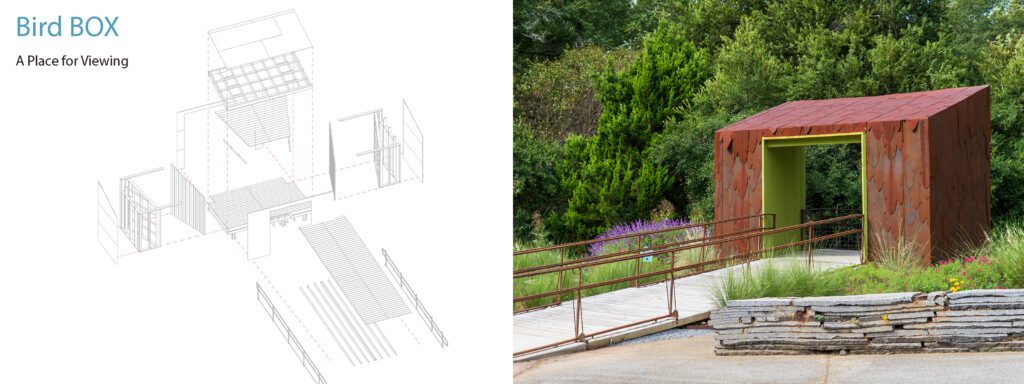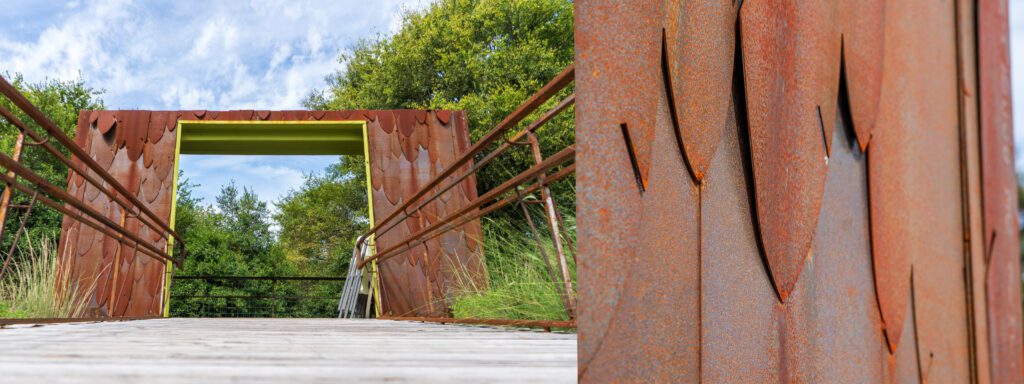The South Carolina Botanical Garden has dedicated a new attraction for birders everywhere—a Birding Garden.
After four years, a pause during the COVID-19 pandemic and hundreds of student and faculty man-hours, the South Carolina Botanical Garden (SCBG), The School of Architecture and the Community Research and Design Center (CR+DC) dedicated the new garden on September 25, 2023.
In Fall 2019, the SCBG, the School of Architecture and the CR+DC began planning to develop a demonstration area that showcased landscapes that support bird populations in residential yards and urban environments.
Shannon Barrett, the assistant director of strategic operations, previously the interim executive director of SCBG and the lead SCBG coordinator for the project, expressed that the garden area is the epitome of ‘plant it, and they will come’ for birds and humans.
“Not even a year since its completion, this space has evolved into a human and bird-friendly ecosystem that engages and educates our visitors on the importance of creating wildlife habitat at all scales,” Barrett said.
How the design came together
The design team, comprised of School of Architecture students, envisioned converting asphalt parking lot material into a retaining wall to support a new garden space for SCBG, with students eventually landing on a retaining wall and pavilion structure for their design.
The completed project, located in an approximately 0.1-acre site, included demolishing and reusing a section of the asphalt parking lot behind the Bob Campbell Geology Museum to give land back to the garden and blend the site with nature. The site also hosts 20 species of perennials, shrubs, vines, grasses and what is now known as “The BirdBOX.”

The BirdBOX is a 128-square-foot pavilion structure shaped like a “visual megaphone.” According to Dan Harding, the director of the CR+DC, the pavilion’s shape serves as a threshold to view the landscape, habitat and birds.
“The pavilion’s box shape is meant to draw users in and project their view out into the garden, assisting them, through design, in focusing on the trees and wildlife,” explained Harding.

The unique design of the pavilion features detailed custom Corten steel shingles which serve as the structure’s protective siding. According to Harding, the shingles were designed as an abstraction of a warbler’s feathers.
“Not only do the shingle shapes resemble a bird’s feathers, but the way that they are applied is indicative of a bird as well,” explained Harding. “These ‘feathers’ were carefully designed to be placed in such a way that they protect the structure from the element, much like a bird’s feathers protect it from the elements.”
The impacts of the Garden
Martin Hamilton, the new executive director of the South Carolina Botanical Garden, noted that the garden delivers on the S.C. Botanical Garden’s vision and mission and showcases their desire to support biodiversity and engage people with nature.
“The accessible building built by Professor Harding’s students from the Community Research and Design Center is a thoughtfully designed structural element in the garden that encourages visitors of all ages and abilities to stop, look and listen,” Hamilton explained. “Coupled with the construction of the retaining wall along the garden’s perimeter using recycled asphalt, the built elements of the garden demonstrate the SCBG commitment to sustainability and access for all.”

According to Harding, the Garden and BirdBOX is a unique project. It provides students and the community with many experiential learning opportunities.
“The project’s impact has extended past the design studio,” explained Harding. ‘By offering visitors of the SCBG opportunities to learn and explore garden strategies that support habitats for various bird populations.”
“This level of sustainable design has been achieved by implementing education and engagement as part of the design process via the inclusion of staff, faculty, students and stakeholders,” Barrett said. “I am so grateful for the opportunity to work with SCBG staff, Dan Harding and his amazing, committed students on-site development for this project.”
Get in touch and we will connect you with the author or another expert.
Or email us at news@clemson.edu

